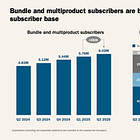ESPN's Rebuttal Revealed The Real Crisis
Management's 20-minute rebuttal on The Grill Room exposed some fundamental problems I missed: ESPN can't sell their own product and is creating "zombie subscribers" instead of engaged viewers.
My podcast interview with The Grill Room came out an hour after Tuesday’s essay was published (Apple Podcasts, Spotify). For those of you who have yet to listen to it, host Dylan Byers—alongside Puck colleague Julia Alexander, who recently worked at Disney —took the unusual step of taking the first 20 minutes to discuss ESPN’s angry responses to the excerpt of my interview published before the Labor Day weekend.
I thought there were a few reasonable counterarguments made.
The most revealing counterpoint was ESPN’s claim that I ignored Pitaro's “interactive” experience at Yahoo and Disney Interactive—suggesting they fundamentally misunderstand why I specifically highlighted “DTC and e-commerce experience” as the undervalued skillsets.
Pitaro has no obvious track record as a DTC or e-commerce entrepreneur building their business “in the trenches” and making the day-to-day decisions on marketing, sales pitches, product development, payments processing or business. His teams at Yahoo and Disney have done that for him, and he has overseen their profit-and-loss statements.
By comparison, New York Times executive David Perpich—now Vice Chairman, The New York Times Company & Publisher of The Athletic— is an archetype of a legacy media executive with a DTC and e-commerce skillset. Prior to business school he helped found and build an online music school called the Scratch DJ Academy (where I pitched him a business partnership 20 years ago). An observer may easily connect the dots from the DTC model of his Scratch DJ days to his 2010 insight that the metered paywall and bundled DTC offerings were the future of the NYT. He has since overseen product launches and experimentation.
A key problem in legacy media businesses over the past 20 years—particularly in the large media companies— is that C-suite executives like Perpich are the exception and executives like Pitaro are the rule. Both oversee profit-and-loss statements with DTC businesses on them. But, only executives like Perpich have the hands-on experience that helps to intimately understand the products team members build or the challenges of new technologies creating new business problems in real-time.
It is rare when we see the latter. When we have—specifically former Disney CEO Bob Chapek and former WarnerMedia CEO Jason Kilar—they were unceremoniously shown the exit door early in their tenures. Otherwise, in the streaming era cable executives like Warner Bros. Discovery CEO David Zaslav have hopped on investor phone calls to sell games and streaming as growth models while betraying a lack of understanding of their underlying business models.
More shareholder value has been destroyed than created with cable executives at the helm of digital media businesses. Meanwhile, the NYT stock is now priced nearly 20% above its previous at all-time highs in 2002.
Identifying Consumer Needs
Byers quoted an “illustrious” digital media executive who argued that the flaw in my argument was that ESPN and The New York Times have “fundamentally different” businesses. When Byers asked what ESPN could do instead, the executive did not offer a solution.
Eugene Wei—former Head of Video at Oculus and previously an executive at Hulu—told Stratechery’s Ben Thompson in 2022 that the internet has “collapsed the barriers between different mediums of content, and made them all accessible to you at all times”. Netflix has consistently messaged this point: It competes for “time and attention” with the likes of YouTube and TikTok, and more broadly “for consumer engagement with different modes of entertainment” like Fortnite.
Both the NYT bundle and ESPN’s “flagship” app face the same competitive dynamics, even if ESPN is focused almost entirely on distributing live sports events.
As for the second point, yesterday I asked a former ESPN executive, “If ESPN were gone tomorrow, which parts of it would consumers still pay to receive on a monthly basis?”




